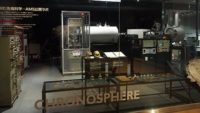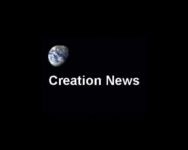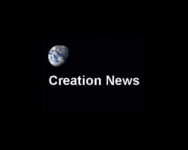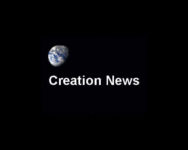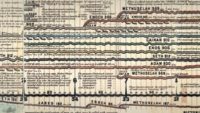Revolving copter blades on drones certainly work, but engineers are eager to attain the advantages of flapping flight, especially at the ‘nano’-scale. …read more Source: creation.com
By Ken Ham “Scientists Succeed in Creating Mouse Artificial Wombs”—now, that might not seem like the most newsworthy headline, considering the myriad of other issues capturing headlines and discussion in the United States and around the world on any given day. But it’s important that we understand what’s going on with scientific advancements like this because they have the potential for good or (and, sadly, more likely) great evil. What do I mean? What happens when it’s no longer mouse embryos but human embryos that are the subject of this experimentation? Well, in a scientific first, researchers in Israel successfully [More]
Whatever the flower colour of your morning glory plant, it did not evolve that way. …read more Source: creation.com
By Dr. Jerry Bergman The history of the mutation theory as the foundation of the source of new genetic information is reviewed. …read more Source: AIG Daily
The new science about DNA that challenges evolution …read more Source: creation.com
Whether pest control experts realize it or not, successful pesticide strategies have been designed from a creationist perspective. …read more Source: creation.com
Scientists have sequenced small amounts of DNA from the teeth of two Siberian mammoths said to have lived more than a million years ago.1,2 The discovery has set an official record for the oldest DNA ever recovered, and it also raises a number of questions relevant to the creation-evolution controversy. Can DNA survive longer than a million years? Creationists have pointed out that original proteins found in dinosaur rem… More… …read more Source: icr.org
Rapid evolution?-Are Aussie snakes really evolving to cope with toxic toads? CMI’s Dr David Catchpoole investigates. …read more Source: creation.com
By Stephen Bartholomew, Jr. In recent years evolutionists have increasingly promoted the evolution of whales as one of the most convincing examples of macroevolution. …read more Source: AIG Daily
The recent discovery of a tiny tyrannosaur jaw bone fragment and a claw has some scientists again pushing dinosaurs as birds.1 But is there any evidence that T. rex had feathers, as so often is portrayed, let alone as young hatchlings? A group of paleontologists, led by Gregory Funston from the University of Edinburgh, have identified the first embryonic bones from a tyrannosaur, a tiny jaw fragment and a claw. … More… …read more Source: icr.org
Have cane toads evolved since invading Australia? Certainly both toads and native fauna have changed-but it’s not evolution. …read more Source: creation.com
By Dr. Don DeYoung Food-gathering slime molds can build a complex network as efficient as Tokyo’s rail system in just 24 hours, without giving it a second thought! …read more Source: AIG Daily
Applying a data filtering method to help clarify created kinds in dinosaur and cephalopod datasets. …read more Source: creation.com
By Dr. Georgia Purdom Exploring how Adam, Methuselah, and Noah in the book of Genesis really lived for centuries and biological/genetic reasons why humans no longer live that long. …read more Source: AIG Daily
How would you do if someone spun you around every few seconds all day long? Marine algae repeatedly get tossed about in coastal surf, and they cope quite well. Researchers want to find out how. The latest set of experiments has revealed built-in machinery that helps these single-celled creatures thrive amid the turbulence. Peering into the ways those cellular systems work invokes big questions about how those systems got there in the first place…. More… …read more Source: icr.org
By Dr. Jerry Bergman An unbridgeable gap exists between the simple urinary system used in invertebrates and the far more complex kidney system used in all vertebrates. …read more Source: AIG Daily
By Dr. David A. DeWitt The diversity of eye, hair, and skin pigmentations across the globe actually demonstrates a genetic relationship with our first parents, Adam and Eve. …read more Source: AIG Daily
God’s engineering marvel that inspired new spray system designs. …read more Source: creation.com
A comparison of morphology-based and genomics-based approaches to understanding the created kinds. …read more Source: creation.com
By Ken Ham Coelacanths aren’t likely to win a beauty contest anytime soon. Featuring dull coloration and white spots, these six-foot-long fish make their home in rocky outcroppings in the deep ocean. Even though they aren’t the flashiest of fish, they might win for being among the most unique, coming equipped with armored scales, paired lobed fins that move in a synchronized fashion (like a helicopter in water!), a hinged skull, an electro-sensory system, and a hollow oil-filled “notochord” backbone. Oh, and they’re also considered “living fossils.” What is a “living fossil”? This term typically describes a living organism that [More]
By Dr. Nathaniel T. Jeanson Genetics confirms the recent, supernatural creation of Adam and Eve and refutes the evolutionary narrative on human origins. …read more Source: AIG Daily
The takeoff and flight of butterflies has long been derided by evolutionists as being an unstable and inefficient product of evolution. However, a new study has shown that the spectacular complexity and efficiency of butterfly wing design is an optimized system worthy of emulating in a new generation of flying robotic drones.1 Butterflies fluttering around a sunny garden grab our curiosity and fascinate us like no other … More… …read more Source: icr.org
Would a robotic dog that could make copies of itself be alive? …read more Source: creation.com
Did multi-celled creatures really evolve from single cells? According to evolutionary theory, living things developed from simpler to more complex organisms over billions of years via several major innovations. One such big step was the evolution of multicellular organisms from single-celled ones. This is a crucial phase of evolution, because multicellular organisms allow for multiple cell tissue types. This in turn permits more variability in living beings, allowing for mutations and natural selection to supposedly create a larger variety of organisms.1 …read more Source: creation.com
By Dr. Nathaniel T. Jeanson Breakthrough findings repudiate Darwin with falsifiable and fulfilled predictions—the gold standard of actual scientific research. …read more Source: AIG Daily
Rare mutation in a Bangladeshi family means they lack fingerprints. Is this evolution in action? …read more Source: creation.com
How an arctic fox’s far-reaching migration testifies to the post-Flood dispersion …read more Source: creation.com






















